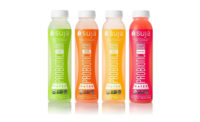The grocery landscape is changing. What were once considered futuristic technologies like drones, robots and artificial intelligence are now merging with grocery retail to expand and re-shape the shopping experience.
In fact, Consumer Reports, Yonkers, N.Y., likens this change to a “retail evolution,” one that shows consumers demanding fresher produce, organic choices, low prices and more convenience from their grocers. In fact, this study says that U.S. shoppers are willing to go beyond their neighborhood supermarket to get what they want.
Grocery and convenience store trends include smaller-footprint stores that offer more limited, “curated” food selections for time-pressed customers, in-store meal kits, home delivery, curbside pickup and partnerships with local farms. The study also forecasts the supermarket of the future, which could include in-store sensors communicating with smartphone apps for easy purchase, no checkout lines and boutique-style “concierges.”
The Food Marketing Institute (FMI), Arlington, Va., released its U.S. Grocery Shopper Trends 2017 analysis, which reveals shopper demand for dimensions of transparency along the supply chain challenged by an evolving marketplace. The research signaled that U.S. grocery shoppers want more than just information; they desire transparency that engages them, offering assurances of food safety, the pursuit of health and wellness, the appetite for discovery and a closer connection to food.
Meanwhile, the majority of consumers see a brighter future for 2017, according to the latest IRI Consumer Connect survey released by Chicago-based IRI. The Q4 2016 findings revealed that 70% of consumers feel their household finances will improve in the next six months, and are willing to pay a premium for higher quality and highly differentiated packaged goods products as well as for the convenience of shopping online.
Influx of e-commerce
According to a survey conducted by Unata, Canada, one out of three consumers will order groceries online in 2017. In fact, the number of U.S. shoppers who bought groceries online in 2016 more than doubled to 19%, up from 8% in 2015. And, the number of U.S. shoppers who buy groceries online will grow by more than 60% this coming year, with 31% saying they are “very likely” or “somewhat likely” to buy groceries online in 2017.
The fundamental shift in the country’s demographics is one of the reasons there is now greater adoption of shopping for foods and beverages online. According to “The Virtual Grocery Store,” a report published by The NPD Group, Chicago, 20 million consumers who are current, lapsed or new to online grocery shopping plan to increase their virtual shopping for foods and beverages over the next six months.
Meanwhile, a study released by FMI and Nielsen, New York, showed that within the next decade, online food shopping will reach maturation in the United States far faster than other industries that have come online before. Research also revealed that the center store is likely to shift online faster than other departments, and that consumer spend on online grocery shopping could reach $100 billion.
Targeting the every consumer
Gone are the days where women rule grocery store aisles. That’s because men now account for 49% of grocery store shoppers, according to the VideoMining Grocery Shopper Impact MegaStudy, produced by VideoMining Corp., State College, Pa. While data from 2012 showed that 12% of shoppers limited themselves to the perimeter, that number has grown to 20% today—meaning one in five shoppers don’t shop center store at all.
Food origin is also an important consideration for today’s shoppers, as they want to know how their food is produced, transported and handled, as outlined in “What’s in Store 2017,” from the International Dairy Deli Bakery Association (IDDBA), Madison, Wis.
U.S. consumers will take a personal approach to their health and wellness in 2017, reports The NPD Group. Wearable devices that track footsteps and apps that track calories enable consumers to develop their own personal plans, rather than rely on health plans based on averages. Even though dieting is on the decline, “my own diet” is still rising as the most common way consumers take control of their intake.
Furthermore, New York-based Siegel+Gale released findings of its seventh annual “Global Brand Simplicity Index,” which reveals that consumers want a simple shopping experience. For instance, 64% of consumers are willing to pay more for simpler experiences, and 61% of consumers are more likely to recommend a brand because it’s simple. And, brands that don’t provide simple experiences are leaving an estimated share of $86 billion on the table.
In the never-ending quest to connect with consumers on a meaningful level, The Hartman Group, Bellevue, Wash., released a Top 10 list of key words that should be part of every food and beverage industry professional’s vocabulary. The Top 10 list includes words like transparency, balance, foodie and Gen Z.
Americans are also taking in food information from more sources than ever before, yet their nutritional literacy is sorely lacking, according to the 12th Annual “Food and Health Survey,” released by the International Food Information Council Foundation (IFIC), Washington, D.C. The vast majority of consumers—eight in 10 (78%)—say that they encounter a lot of conflicting information about what to eat/avoid. More than half of those (56%) say the conflicting information makes them doubt the choices they make.
M&As drive growth
On the heels of another post-recession record year in consumer and retail mergers and acquisitions (M&A), deal making will rise once again in 2017, accompanied by a rebound in valuations, according to A.T. Kearney’s new report, “Off to New Peaks in Uncertain Times.”
In 2016, 58 megadeals were valued at more than $1 billion, with consumer goods and food companies posting a 46% jump. The primary drivers of M&A—slow growth, consolidation, plentiful capital and strong balance sheets—will remain in place, but the report predicts a rise in deal values and a more complex political environment for cross-border M&A.
Based on interviews with C-level retail executives, 67% of whom anticipate an increase in M&A activity, along with analysis of retail transactions from the past 10 years, the report outlines three predictions—stratification of deals with higher valuations at the extremes, a bump in deals backed by private equity and growth across global markets.
New product development experiences uptick
In 2016, food and beverage companies introduced 21,435 new items on U.S. retail shelves—new package sizes, new flavors, new packaging and true new products, according to Mintel’s Global New Products Database.
New beverages accounted for 18.5% of new food and beverage products in 2016, with snacks coming in second with a 14.8% share.
Menu concepts infiltrating retailers’ aisles
One of the biggest trends impacting the cold food industry is the infiltration of menu concepts landing on retailers’ shelves. Quick-service restaurants (QSRs) like P.F. Chang’s, Chili’s, White Castle and Buona Beef are turning menu favorites into one that consumers can enjoy at home whenever they want.
Meanwhile, brands most notably known in the shelf-stable aisles are entering the more temperature-sensitive ones. For example, Hostess Brands, LLC, Kansas City, Mo., collaborated with Nestlé Dreyer’s Ice Cream Co., Fort Wayne, Ind., to launch Hostess frozen novelties and ice cream, where Nestlé will manufacture and distribute the new products under the Hostess brands. Additionally, Kraft Heinz Co., Pittsburgh, Pa., introduced VELVEETA Stuffed Grilled Cheese and VELVEETA Cheesy Bites, available in the freezer aisle.
Even retailers themselves are getting in on the action by developing their own take on popular SKUs. For instance, Kroger, Cincinnati, introduced prepared meal kits called Prep+Pared, which are fresh-made, chef-inspired, restaurant-quality and can be easily prepared at home.
Millennials and Generation X consumers are 321% more likely to purchase meal kits than older generations, according to research released by Nielsen. Busy families with children are also enjoying the convenience and healthy options meal kits have to offer, purchasing them 326% more than households without children.
Meanwhile, 81% of consumers feel that meal subscription services are healthier than the prepared options at grocery stores. And, while many consumers prefer to choose their own produce, 92% are satisfied with the quality of produce included in their meal kits, while 91% say they’re satisfied with the quality of the meat packaging.
Brand loyalty trumps private label
When the Recession hit, consumers turned to private label as more affordable alternatives to their coveted brands. Now, the tables are turning back, and new research from Foodmix Marketing Communications, Elmhurst, Ill., reveals 58% of brand lovers admit to hoarding their all-time favorite food product. Eighty-six percent will recommend a loved branded food product to family and friends whenever they can, and one in four food brand lovers share photos of the brand’s products on social media.
Organic still onward and upward
The robust American organic sector stayed on its upward trajectory in 2016, gaining new market share and shattering records, as consumers across the United States ate and used more organic products than ever before, according to the 2017 Organic Industry Survey, conducted by the Organic Trade Association, Washington, D.C.
Organic sales in the United States totaled around $47 billion in 2016, reflecting new sales of almost $3.7 billion from the previous year. The $43 billion in organic food sales marked the first time the American organic food market has broken through the $40 billion mark. Organic food now accounts for 5.3% of total food sales in this country, another significant first for organic.
Going paperless
Analysis of 2016 coupon activity by Inmar, Inc., Winston-Salem, N.C., shows an ongoing “promotional transposition” with paperless, as digital coupons begin to overtake traditional paper coupons in popularity. The study reveals that, among the more than 2.2 billion coupons redeemed by shoppers last year, the share of redemption captured by offers that are loaded directly to shoppers’ retailer loyalty accounts (load-to-card) grew 20% between 2015 and 2016. In comparison, share of redemption for paper coupons found in the Sunday newspaper (free-standing inserts) fell 10% over the same period.
At the same time, Inmar’s research finds shoppers reporting for the first time ever that they use load-to-card offers more often than coupons found in free-standing inserts or store circulars.
Similarly, smartphones and tablets now account for 72% of online searches that result in a visit to a food and beverage website, the greatest of any of the sectors analyzed, according to Hitwise, a New York-based division of Connexity. The study, “Mobile Search: Topics & Themes,” outlines that location-based searches are among the most heavily skewed to mobile.
Sustainability sells
Plant-based proteins and flexitarian and vegan options will continue to increase in popularity, according to New York-based Ketchum’s inaugural survey of nutrition experts. Nutrition experts anticipate Instagram and food/health apps (66% and 68%, respectively) will play a bigger role in influencing food choices in 2017.
The rise of HPP
The market for high-pressure processing (HPP) equipment is projected to reach $500.3 million by 2022, at a CAGR of 11.26% from 2016, according to a report published by MarketsandMarkets, New York. The study also outlined that fruits and vegetables accounted for the largest share in the application of HPP equipment in 2015, with United States dominating the geographic market.
Factors such as increased consumption of packaged foods, a rise in ready-to-cook meat production, government assistance toward developing food technologies and a widening applicability of HPP equipment are key drivers in the growth of HPP equipment, in addition to the already cemented uses of promoting food safety and extending shelf life.
Here is this year's State of the Industry Report:
2017 Best New Retail Products Contest
The votes are in for Refrigerated & Frozen Foods’ 2017 Best New Retail Products contest.
Convenience keeps ready meals at consumers’ fingertips
Frozen pizzas' continued move to higher quality and greater variety appears to be helping the overall category increase dollar sales.
Prepared foods drive growth in sides category
Prepared foods accounted for 58% of the $24 billion in deli sales in mid-2016, and are considered an emerging driver of growth.
Pork, sustainable seafood trend up
The USDA projects that beef and pork production will expand steadily between 2016 and 2025.
Changing consumer patterns create uptick in retail baked goods sector
An increase in demand for convenient food products and the trend for greater taste, safety and consistency are also major factors driving the global frozen bakery products market.
Year-round ice cream heats up dairy aisle
Ice cream is among the largest supermarket food categories, one of only 10 with double-digit billion dollar sales.
The global frozen fruits and vegetable market will grow at an annual rate of 5.34% and reach 751 million tons by 2027.
On-the-go breakfast sparks innovation
Consumers continue to embrace snacking, which is causing changes in consumers’ relationships with traditional breakfast foods.
Dips reign as powerhouse products
From intricate flavoring to the influx of high-pressure processing (HPP) technology, the refrigerated dips and spreads market continues to experience elevated growth.
Flavor, functionality drive growth in refrigerated beverages
Changing demographics and purchasing behaviors make it crucial for beverage industry leaders to understand and capitalize on key consumer insights.
Private label drives frozen desserts category
Looking ahead, there are good reasons to believe that private label frozen desserts will continue to gain market share.
Market Research Report Reveals Challenges, Future of Cold Food Industry
Refrigerated & Frozen Foods collaborated with BNP Media’s market research division, Troy, Mich., to conduct a market research report to better understand industry trends within the refrigerated and frozen foods industry. The study reached 6,385 readers during April 18-May 2. Here’s a snapshot of the results:
- 86% of respondents use energy management solutions, with 64% using a recycling program, 52% promoting sustainability and 50% installing LED lighting.
- 44% of respondents have expanded their facilities or created new ones in the past 12 months. Almost all respondents (94%) have not implemented a recall of any kind within the past 12 months.
- Food safety features (92%), return on investment (92%) and productivity (91%) are the most important attributes when purchasing food and beverage manufacturing equipment.
- 62% of respondents find food safety regulations as one of the top challenging factors in today’s food and beverage processing environment, followed by employee turnaround (44%) and new product development (36%).
- Readers expect slightly more growth in the refrigerated industry (54%) than frozen (46%), with snacks, appetizers and side dishes experiencing the most growth (63%), followed by beverages (48%) and fruits and vegetables (47%).
Go to www.clearmarkettrends.com to purchase and download the entire report as well as access a wide inventory of other studies done in this industry. You can also email info@clearmarkettrends.com.




